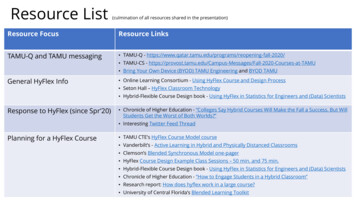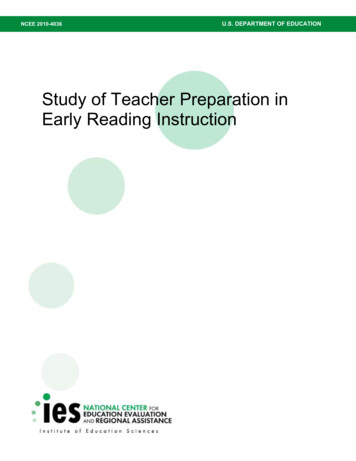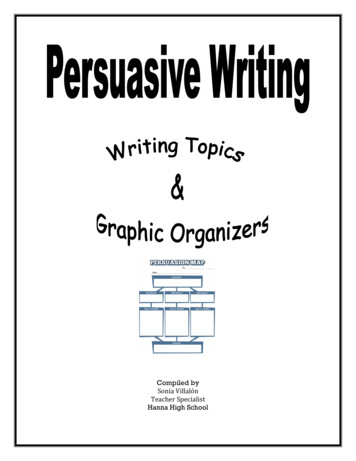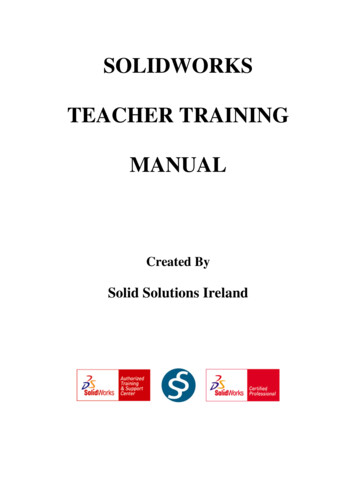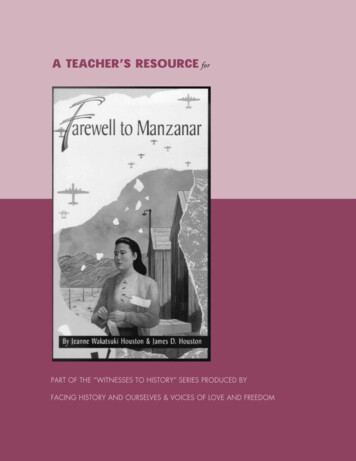
Transcription
A TEACHER’S RESOURCE forFarewell to Manzanarby Jeanne Wakatsuki Houston& James D. HoustonPart of the “Witnesses to History” series produced byFacing History and Ourselves & Voices of Love and Freedom
AcknowledgmentsVoices of Love and Freedom (VLF) is a nonprofit educational organization that promotes literacy, values, and prevention. VLF Teacher Resources are designed to helpstudents: appreciate literature from around the world develop their own voices as they learn to read and write learn to use the values of love and freedom to guide their lives and live healthy lives free of substance abuse and violence.Voices of Love and Freedom was founded in 1992 and is a collaboration of the JudgeBaker Children’s Center, Harvard Graduate School of Education, City University ofNew York Graduate School, and Wheelock College.For more information, call 617-635-6433, fax 617-635-6422,e-mail VLFBOSTON@aol.com, or write Voices of Love and Freedom,67 Alleghany St., Boston, MA 02120.Facing History and Ourselves National Foundation, Inc. (FHAO) is a national educational and teacher training organization whose mission is to engage students ofdiverse backgrounds in an examination of racism, prejudice, and antisemitism inorder to promote the development of a more humane and informed citizenry. Bystudying the historical development and lessons of the Holocaust and other examples of genocide, students make the essential connection between history and themoral choices they confront in their own lives.For more information, contact FHAO, National Office, 16 Hurd Road, Brookline, MA 02445; 617-232-1595; http://www.facing.org.FHAO Guide Review Committee: Phyllis Goldstein, Marc Skvirsky, Margot SternStrom.Harcourt General Charitable Foundation, Inc. has awarded a grant to VLF andFHAO to jointly produce teacher resources for the secondary grades. Other fundersof this unique project include the following organizations: The Boston Company,Carnegie Corporation of New York, Facing History and Ourselves Young LeadershipNetwork, New England Hi-Tech Charity Foundation, Parametric Technology Corporation, the Surdna Foundation, and The TJX Companies, Inc.Teacher Resource Writer: Phyllis Goldstein, FHAODesign and Production: Lolly Robinson, interior; Jenifer Snow, coversThis teacher resource is based on the following edition: Farewell to Manzanar by Jeanne Wakatsuki Houstonand James D. Houston, Bantam Books, 1973.Teacher Resource 1999 Voices of Love and Freedon, Inc. and Facing History and Ourselves NationalFoundation. All rights reserved. Not to be reproduced without permission.iiFarewell to ManzanarVoices of Love and Freedom Facing History and Ourselves
Table of ContentsWitnesses to History . . . . . . . . . . . . . . . . . . . . . . . . . . . . . . . . . . . . . . . . . . vAbout the Book . . . . . . . . . . . . . . . . . . . . . . . . . . . . . . . . . . . . . . . . . . . . . viiiStory SummaryCritical Responses to the BookAbout the AuthorsThe Context of the StoryAbout the Teacher Resource . . . . . . . . . . . . . . . . . . . . . . . . . . . . . . . . . . xivExploring the Central QuestionResource OverviewLiterary AnalysisSocial Skills and ValuesReading 1: Defining Injustice (pages ix–33) . . . . . . . . . . . . . . . . . . . . 1To Connect . . . . . . . . . . . . . . . . . . . . . . . . . . . . . . . . . . . . . . . . . . . . . . . . . 1Introduce the Central QuestionWhole Class Discussion: Describing InjusticeTeacher Activity: Experiences of InjusticePartner Sharing: Experiences of InjusticeWhole Class Viewing: Introduction to Farewell to ManzanarWrap-Up SuggestionsTo Read . . . . . . . . . . . . . . . . . . . . . . . . . . . . . . . . . . . . . . . . . . . . . . . . . . . .3To Discuss . . . . . . . . . . . . . . . . . . . . . . . . . . . . . . . . . . . . . . . . . . . . . . . . . . 4Historical Sidelights: The Joe DiMaggio FactorTo Practice . . . . . . . . . . . . . . . . . . . . . . . . . . . . . . . . . . . . . . . . . . . . . . . . . 7Partner Activity: Analyzing a DocumentTo Express . . . . . . . . . . . . . . . . . . . . . . . . . . . . . . . . . . . . . . . . . . . . . . . . . .8Writing Activity: Expressing a Point of ViewJournal SuggestionsRelated Readings and VideosReading 2: Questions of Loyalty (pages 34–65) . . . . . . . . . . . . . . . .10To Read . . . . . . . . . . . . . . . . . . . . . . . . . . . . . . . . . . . . . . . . . . . . . . . . . . . 11To Discuss . . . . . . . . . . . . . . . . . . . . . . . . . . . . . . . . . . . . . . . . . . . . . . . . .11To Practice . . . . . . . . . . . . . . . . . . . . . . . . . . . . . . . . . . . . . . . . . . . . . . . . 13Partner Activity: Reading for MeaningSmall Group Activity: Mock TrialsHistorical Sidelights: Concentration CampsTo Express . . . . . . . . . . . . . . . . . . . . . . . . . . . . . . . . . . . . . . . . . . . . . . . . . 15Writing Activity: Writing an OpinionHistorical Sidelights: Second OpinionsJournal SuggestionsRelated Readings and ViewingsReading 3: Free to Go (pages 66–107) . . . . . . . . . . . . . . . . . . . . . . . . 17To Read . . . . . . . . . . . . . . . . . . . . . . . . . . . . . . . . . . . . . . . . . . . . . . . . . . . 17Voices of Love and Freedom Facing History and OurselvesFarewell to Manzanariii
To Discuss . . . . . . . . . . . . . . . . . . . . . . . . . . . . . . . . . . . . . . . . . . . . . . . . . 17Historical Sidelights: Japanese Americans in the Armed ForcesTo Practice . . . . . . . . . . . . . . . . . . . . . . . . . . . . . . . . . . . . . . . . . . . . . . . . 19Partner Activity: “Don’t Fence Me In”To Express . . . . . . . . . . . . . . . . . . . . . . . . . . . . . . . . . . . . . . . . . . . . . . . . . 20Writing Activity: Concentration ConstellationJournal SuggestionsRelated Readings and ViewingsReading 4: Re-Entry (pages 108–130) . . . . . . . . . . . . . . . . . . . . . . . . . 22To Connect . . . . . . . . . . . . . . . . . . . . . . . . . . . . . . . . . . . . . . . . . . . . . . . .22To Read . . . . . . . . . . . . . . . . . . . . . . . . . . . . . . . . . . . . . . . . . . . . . . . . . . . 23To Discuss . . . . . . . . . . . . . . . . . . . . . . . . . . . . . . . . . . . . . . . . . . . . . . . . . 23To Practice . . . . . . . . . . . . . . . . . . . . . . . . . . . . . . . . . . . . . . . . . . . . . . . . 24Partner Brainstorming: Analyzing QuestionsTo Express . . . . . . . . . . . . . . . . . . . . . . . . . . . . . . . . . . . . . . . . . . . . . . . . . 24Writing Activity: Expressing a Point of ViewJournal SuggestionsRelated ReadingsReading 5: Confronting the Past (pages 131–145) . . . . . . . . . . . . . 26To Read . . . . . . . . . . . . . . . . . . . . . . . . . . . . . . . . . . . . . . . . . . . . . . . . . . . 26To Discuss . . . . . . . . . . . . . . . . . . . . . . . . . . . . . . . . . . . . . . . . . . . . . . . . . 26Independent Writing Activity: Reader ResponsesTo Practice . . . . . . . . . . . . . . . . . . . . . . . . . . . . . . . . . . . . . . . . . . . . . . . . 28Whole Class Discussion: A Matter of JusticeTo Express . . . . . . . . . . . . . . . . . . . . . . . . . . . . . . . . . . . . . . . . . . . . . . . . . 29Final Writing Activity: Stories of InjusticeRelated Readings and VideosReproduciblesExperiences of Injustice . . . . . . . . . . . . . . . . . . . . . . . . . . . . . . . . . . . 32Executive Order 9066 . . . . . . . . . . . . . . . . . . . . . . . . . . . . . . . . . . . .33In Response to Executive Order 9066 . . . . . . . . . . . . . . . . . . . . . . . . . .34Can’t Tell . . . . . . . . . . . . . . . . . . . . . . . . . . . . . . . . . . . . . . . . . . . . . . 35Amendments to the Constitution . . . . . . . . . . . . . . . . . . . . . . . . . . .36Hirabayashi v. United States . . . . . . . . . . . . . . . . . . . . . . . . . . . . . . . .38Korematsu v. United States . . . . . . . . . . . . . . . . . . . . . . . . . . . . . . . . .39Ex Parte Mitsuye Endo . . . . . . . . . . . . . . . . . . . . . . . . . . . . . . . . . . . .41Internment Camps . . . . . . . . . . . . . . . . . . . . . . . . . . . . . . . . . . . . . . .42Concentration Constellation . . . . . . . . . . . . . . . . . . . . . . . . . . . . . . . . .43Analyzing Quotations . . . . . . . . . . . . . . . . . . . . . . . . . . . . . . . . . . . .44Reader Responses . . . . . . . . . . . . . . . . . . . . . . . . . . . . . . . . . . . . . . . .45Proclamation 4417: An American Promise . . . . . . . . . . . . . . . . . . . . .46A Letter to Japanese Americans . . . . . . . . . . . . . . . . . . . . . . . . . . . . .47Stories of Injustice . . . . . . . . . . . . . . . . . . . . . . . . . . . . . . . . . . . . . . .48ivFarewell to ManzanarVoices of Love and Freedom Facing History and Ourselves
Witnesses to HistoryIt has been said that memory is the imprint of the past upon us as individuals and asmembers of a family, an ethnic or religious group, a community, even a nation. Ourmemory is also the keeper of what is most meaningful to our deepest hopes and ourgreatest fears. Voices of Love and Freedom and Facing History and Ourselves havecreated teacher resources for six literary works that focus on individual encounterswith history in ways that deepen our understanding of the connections between pastand present. Each also reveals the importance of confonting history in all of its complexity, including its legacies of prejudice and discrimination, resilience and courage.Voices of Love and Freedom and Facing History and Ourselves have developed aTeacher Resource for each of the following titles:The Giver by Lois Lowry—a futuristic novel that explores the relationship betweenpast and present, between identity and memory. The Central Question: How doour individual and collective memories shape who we are today and influence ourfutures?Night by Elie Wiesel—a memoir that focuses on the final year of the Holocaust—ayear the author spent at Auschwitz, a Nazi death camp. The Central Question:What is the relationship between our stories and our identity? To what extent are weall witnesses of history and messengers to humanity?Farewell to Manzanar by Jeanne Wakatsuki Houston and James D. Houston—anaccount of a young girl’s experiences at an internment camp in the United Statesduring World War II. It reveals how the time Jeanne Wakatsuki spent at Manzanarshaped her identity—her sense of who she is and what she might become. The Central Question: How do our confrontations with justice and injustice help shape ouridentity? How do those confrontations influence the things we say and do?Warriors Don’t Cry by Melba Pattillo Beals—a first-hand account of the integrationof Central High School in Little Rock, Arkansas, in 1957. The book explores notonly the power of racism but also such ideas as justice, identity, loyalty, and choice.The Central Question: What can we do alone and with others to confront racism?How can we as individuals and as citizens make a positive difference in our school,community, and nation?Kaffir Boy: The True Story of a Black Youth’s Coming of Age in Apartheid South Africaby Mark Mathabane—a first-person narrative about the impact of racism and segregation on a young black South African in the 1970s. The book can be used to deepenan understand not only of racism but also of such concepts as identity, resilience, andresistance. The Central Question: What are different ways we struggle for freedom?The Joy Luck Club by Amy Tan (coming in fall, 1999).Voices of Love and Freedom Facing History and OurselvesFarewell to Manzanarv
Teacher ResourcesEach teacher resource is organized around a central theme or question related to thetheme of the work. The following strategies are used to develop the central questionand related ideas and promote literacy and social skills.Central Theme or QuestionWhile several themes from the story are explored in the teacher resource, the centraltheme has been selected to assure that activities build upon one another and providestudents with a deep understanding of a key aspect of the story.To ConnectThe activities in the To Connect sections of the resources are pre-reading activities.They include suggestions for introducing the central theme, using teacher and student stories to encourage a connection with the central theme, discussing key concepts, and providing an historical and conceptual context for understanding the literary work. One of the primary purposes of these activities is to help students toconnect their own personal experience to the issues raised in the story prior to readingthe story.To DiscussAfter reading the story or a section of the story, a variety of discussion questions helpteachers foster a lively conversation that deepens comprehension and widens students’ perspectives. These questions also encourage interpretation of the text anddevelop important concepts as well as reinforce speaking, listening, and criticalthinking skills.To PracticeAfter students have read and discussed a story (or section), a variety of interactiveactivities provide practice in key literacy and social skills. Some of these activitiesinvolve the whole class in reenactments of key scenes, role playing, and debates. Others are partner or individual activities that provide opportunities to practice literacyskills (listening and speaking) and/or social skills (perspective taking and conflict resolution).To ExpressStudents are encouraged to reveal their understanding of the story through the use ofjournals and structured writing activities. These activities help students appreciatethe author’s craft as well as develop their own writing skills. At the end of eachteacher resource, the Final Writing Activity helps students express their understanding of the book and their responses to the Central Question.To ParticipateSome teacher resources contain suggestions for engaging students in community service projects at school, in the home, or in the neighborhood. These activities buildon insights and values developed through reading and discussing the story.viFarewell to ManzanarVoices of Love and Freedom Facing History and Ourselves
Voices of Love and FreedomVoices of Love and Freedom is a K–12 educational organization that helps studentsappreciate literature from around the world, develop their own voices as they learn toread and write, learn to use the values of love and freedom to guide their lives, andlive healthy lives free of substance abuse and violence.Facing History and OurselvesFacing History and Ourselves is an educational organization that helps teachers andtheir students find meaning in the past and recognize the need for participation andresponsible decision making. By providing an interdisciplinary framework for examining the meaning and responsibilities of citizenship, Facing History expands knowledge, challenges thinking, and stretches students’ imagination.Voices of Love and Freedom Facing History and OurselvesFarewell to Manzanarvii
About the BookStory SummaryJeanne Wakatsuki was just seven years old on December 7, 1941, the day Japanattacked Pearl Harbor, the main American naval base in Hawaii. The next day, theUnited States entered World War II by declaring war on Japan. A few months later,the United States government authorized the removal of all Japanese Americans*—young and old, aliens and citizens alike—from the West Coast. They were sent toprison camps surrounded by barbed wire and guarded by armed soldiers. Not one ofthem had been tried for a crime or even charged with wrongdoing. They wereimprisoned solely because of their ancestry.According to the authors, Farewell to Manzanar is a “web of stories tracing a fewpaths, out of the multitude of paths that led up to and away from the experience ofthe internment.” That web of stories links Jeanne’s search for her own unique identity to the wrongs done to Japanese Americans during the war.The book begins on the first Sunday in December of 1941, the day Japanlaunched a surprise attack on the American naval base at Pearl Harbor, Hawaii. It isa day that changes Jeanne’s life and the lives of everyone in her family. Just two weekslater, FBI agents take Jeanne’s father into custody and ship him to a prison camp inNorth Dakota. In the weeks that follow his arrest, her mother moves the family againand again as restrictions on people of Japanese descent tighten. Many other Americans now openly question the loyalty of Japanese Americans. They are increasinglyviewed with fear and distrust.In February of 1942, President Franklin D. Roosevelt issues Executive Order9066. It gives the War Department the power to define military areas in the westernstates and exclude from them anyone who might threaten the war effort. The resultis internment for all Japanese Americans who live along the West Coast of the UnitedStates, including the Wakatsukis. The family is taken to Manzanar, a prison camp inthe California desert.Over the next few months, they, like their neighbors, struggle to maintain theiridentity in an environment that does not support their efforts. No one is more outraged by the indignities of internment than Jeanne’s father. He is released fromprison in North Dakota in September of 1942 and permitted to join his family atManzanar. Imprisonment has humiliated him. So have questions about his loyalty.Jeanne describes him as numbing the pain of his humiliation with home-madeliquor.In the fall of 1945, just after the war ends, Manzanar is officially closed and theWakatsukis settle in a housing project near Long Beach. There Jeanne tries desperately to fit in but never quite succeeds. She and her father quarrel constantly over herbehavior. “While I was striving to become Miss America of 1947,” she recalls, “hewas wishing I’d be Miss Hiroshima of 1904.”Just before Jeanne’s senior year in high school, Jeanne’s father begins to put his* The term is used to refer to both Japanese nationals living in the United States and UnitedStates citizens of Japanese descent.viiiFarewell to ManzanarVoices of Love and Freedom Facing History and Ourselves
life together again. He moves the family to San Jose where he takes up farming. Themove provides Jeanne with an opportunity to start over. Her new classmates elect hercarnival queen and for a brief moment, she thinks that she finally belongs. But as shetakes part in the carnival, over her father’s objections, she suddenly realizes that shehas lost her identity. She does not come to terms with her past until she and her husband visit the former prison camp with their children in 1972. Soon after, she beginsto write Farewell to Manzanar.Critical Responses to the BookOver the years, Farewell to Manzanar has received much critical acclaim. Soon afterthe book was published in 1973, Publisher’s Weekly described it as “a sober and moving personal account of how our government treated children in the name ofNational Security.”* The New York Times called it “an often vivid, impressionisticpicture of how the forced isolation affected the internees. All in all, a dramatic,telling account of one of the most reprehensible events in the history of America’streatment of its minorities.”**Dorothy Bryant, a reviewer for The Nation, was particularly struck by the waythe authors link history to personal experience. In her opinion they are “not simplytrying to communicate facts as Jeanne knew them but were themselves on a search totouch the truth of her experience, to examine it, and to understand it wholly. Thegreat strength of the book is the sense it gives the reader of being allowed to accom†pany Jeanne on this most personal and intimate journey.”Elaine H. Kim, the author of Asian American Literature, is also struck by Jeanne’spersonal journey. She points out that even though the Houstons regard the book as away of confronting the legacies of Manzanar, “shame, guilt, and a sense of unworthiness,” Jeanne is left with “a tiny sliver of suspicion about the very person I was.” Kimgoes on to say:It is this “tiny sliver of suspicion” that may explain the curious incongruitybetween the book’s tone, which is tough and resilient, and its content, which ischaracterized everywhere by diffidence. In an interview, Jeanne Houston stated:“I never considered myself a writer. I couldn’t have written it without[James]. The voice is mine, the viewpoint is mine. The technique and thecraft is James.” The diffidence and sense of unworthiness that remain as a “tinysliver” in Farewell to Manzanar may explain why Jeanne Houston’s story had tobe told by someone else. In every case where one person tells another’s story,some elements are lost and others gained. And though Jeanne Houston couldoversee her husband’s work, his vision no doubt shaped the portrayal of her††experiences.* “Farewell to Manzanar,” Publisher’s Weekly, August 20, 1973.** “Farewell to Manzanar,” The New York Times Book Review, January 13, 1974.†Dorothy Bryant, “The School Yearbook with the Barbed-Wire Design,” The Nation,November 9, 1974.††Elaine H. Kim, Asian American Literature. (Temple University Press, 1982), 88–89.Voices of Love and Freedom Facing History and OurselvesFarewell to Manzanarix
A television screenplay written by the Houstons and based on the book has alsobeen widely praised. It received the Humanitas Prize in 1976, the ChristopherAward, and an Emmy nomination.About the AuthorsBorn in 1934, Jeanne Wakatsuki was eleven years old when World War II ended andher family left Manzanar. The youngest of ten children, she was the first in her family to attend college. She studied sociology and journalism at San Jose State College,where she met her husband, James D. Houston, also a native Californian. He wasborn in San Francisco in 1933.Soon after the Houstons were married in 1957, they went to Europe as a part ofJames’s tour of duty with the Air Force. They stayed an extra year to travel and study.After their return to the United States, they settled in Santa Cruz where James taughtfiction at the University of California at Santa Cruz.James Houston is the author of several novels, including Between Battles; Gig, ANative Son of the Golden West; Continental Drift; and Love Life. He has also produceda number of nonfiction works. One of his books, Californians: Searching for theGolden State, received the Before Columbus Foundation American Book Award.Houston was also the recipient of the Wallace Stegner Writing Fellowship at StanfordUniversity and the Joseph Henry Jackson Award for Fiction.Jeanne Houston did very little writing before the publication of Farewell to Manzanar. Since then, she has written a number of autobiographical essays as well as abook entitled Beyond Manzanar and Other Views of Asian-American Womanhood. In1984, she received the Wonder Woman Award, given annually to an Americanwoman over the age of forty for outstanding achievements in the pursuit of truth andpositive social change.xFarewell to ManzanarVoices of Love and Freedom Facing History and Ourselves
The Context of the StoryOn December 7, 1941, Japanese airplanes launched an attack on the United Statesfleet at Pearl Harbor, the main American naval base in Hawaii. The next day, Congress declared war on Japan. Within days, Germany and Italy, Japan’s allies inEurope, were also at war with the United States.Myths, Prejudice, and WarShaken by the raid, many Americans wanted to know what went wrong. How werethe Japanese able to carry out such a devastating attack? Why wasn’t the UnitedStates able to stop them? In recent years, historians and other scholars have suggesteda number of answers to those questions. Some believe that the Japanese were able tocatch the nation off guard because many American officials were certain that theJapanese were “incapable” of developing modern weapons. As a result, they ignoredevery indication that Japan had both the technology and the skill necessary to do so.It was more comforting to believe that all the Japanese could do was “copy Americanblueprints and then go wrong in the making.” John Hersey notes:Despite four years’ demonstration of the skill and dispatch—and cruelty—ofthe Japanese invasion of China, American military commanders in the Philippines and elsewhere issued boastful statements, over and over again, about howquickly the Japs, as they were scornfully called, would be wiped out if they daredattack American installations. Then suddenly, within hours, the United StatesPacific fleet was crippled at anchor. The United States air arm in the Philippineswas wrecked on the ground. American pride dissolved overnight into Americanrage and hysteria—and nowhere so disastrously as on the country’s westernshores.*That rage was directed not at the nation’s leaders but at Americans of Japanesedescent. They were accused of being an “enemy race” different from and inferior toother Americans. It was not a new charge. For over 50 years, many Americans hadseen newcomers from Japan and other parts of Asia as a threat to the “American standard of living” and to “the racial integrity of the nation.” Newspapers and magazinesrepeatedly warned of the “yellow peril.” Those fears were reflected in federal laws. Asearly as 1790, “non-white” immigrants were barred from citizenship. After the CivilWar, that law was changed to allow immigrants from Africa to become citizens butnot newcomers from Asia. Indeed, in 1882, Congress banned all immigration fromChina. In the years that followed, that ban was expanded to include newcomers fromother parts of Asia, including Japan and the Pacific islands.State and local laws also reflected the belief that people of Asian descent wereinferior. California and several other states outlawed marriages between Asian andwhite Americans. They also prohibited “Asiatic aliens” from owning land within* “A Mistake of Terrifically Horrible Proportions” by John Hersey in Manzanar by Jon Armorand Peter Wright. (Times Books, 1988), 11–12.Voices of Love and Freedom Facing History and OurselvesFarewell to Manzanarxi
state borders. No person of Asian descent, immigrant or native-born, could live inmany neighborhoods or hold jobs in many industries.Such laws had the support of not only politicians but also ministers, teachers,and scientists. Indeed, a number of scientists were so certain that “race” explained allof the cultural differences they observed in the world that they distorted facts ormade claims they could not substantiate. Scientists who pointed out that there wereno “pure races” or noted that there were more differences among people of the same“race” than there were between the “races” were ignored.Despite myths about and prejudices toward the Japanese, the United States didnot distinguish among “enemy aliens” at first. Early in 1942, about 10,000 citizensof Japan, Germany, and Italy were ordered away from specific areas along the Pacificcoast for reasons of “military necessity.” Still from the start, that order and the onesthat followed applied mainly to people of Japanese descent. Among those taken intocustody soon after the war began were Shinto priests, teachers in Japanese languageschools, officers in Japanese communal organizations, and newspaper editors. Manyspent the war behind bars even though they were never brought to trial or even formally charged with a crime.Unlike German and Italian aliens, people of Japanese descent had very littlepolitical influence. After all, no one born in Japan could become a citizen of theUnited States. So long after the federal government had reduced or eliminatedrestrictions on Italian and German aliens, limitations on Japanese Americansremained. To escape those restrictions, several thousand Japanese Americans tried toleave the West Coast for other parts of the country. Most quickly returned. A government report explains why:[Japanese Americans] who tried to cross into the interior states ran into all kindsof trouble. Some were turned back by armed posses at the border of Nevada;others were clapped into jail and held overnight by panicky local peace officers;nearly all had difficulty in buying gasoline; many were greeted by “No Japswanted” signs on the main streets of interior communities; and a few werethreatened, or felt that they were threatened, with possibilities of mob violence.*Executive Order 9066In 1942, there were about 127,000 Japanese Americans in the continental UnitedStates. Over 93,000 of them made their homes in California and another 19,000lived in Washington and Oregon. About two-thirds were born in the United Statesand were therefore American citizens. The rest were Japanese nationals, most ofwhom had settled in the United States before 1924—the year the nation banned allimmigration from Asia.Throughout the winter of 1941–42, both groups found themselves underincreasing attack. A Los Angeles newspaper reported that armed Japanese were inMexico ready to attack. There were also rumors that Japanese fishermen were plant* Quoted in Roger Daniels, Prisoners Without Trial. (Hill and Wang, 1993) 49.xiiFarewell to ManzanarVoices of Love and Freedom Facing History and Ourselves
ing mines in the nation’s harbors, blowing up tunnels, and even poisoning the watersupply. There was no truth to the rumors, but they encouraged General JohnDeWitt, the head of the Western Defense Command, to label all Japanese Americans“a menace which had to dealt with.”In response to pressure from individuals and groups on the West Coast, President Franklin D. Roosevelt issued Executive Order 9066 on February 19, 1942. Itauthorized the army to “designate military areas” from which “any persons may beexcluded.” Although the words Japanese American never appeared on the order, itsmeaning was clear. On March 24, General DeWitt began forcibly removing everyperson of Japanese ancestry from the West Coast, citizen and alien alike.In city after city along the Pacific Ocean, posters tacked to telephone polesordered Japanese Americans to report to one of 64 “civil control stations.” There thehead of each
develop their own voices as they learn to read and write learn to use the values of love and freedom to guide their lives and live healthy lives free of substance abuse and violence. . The



